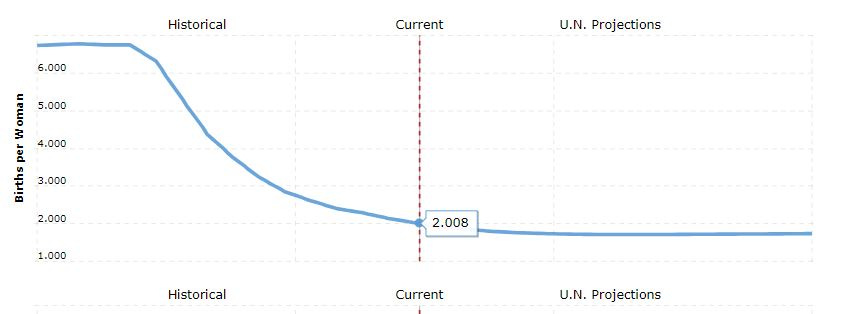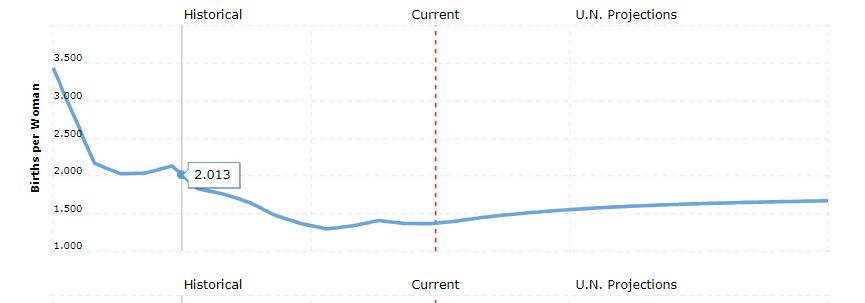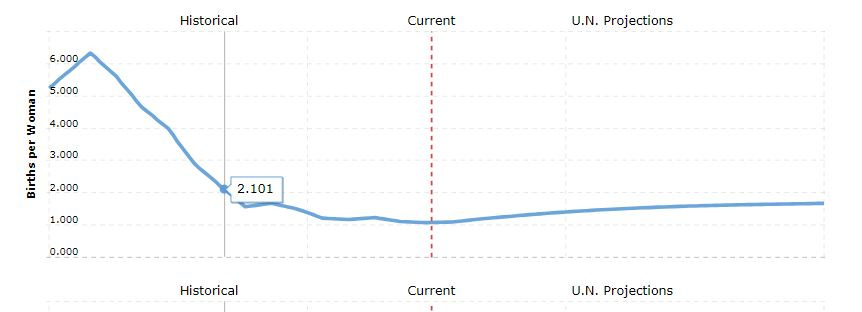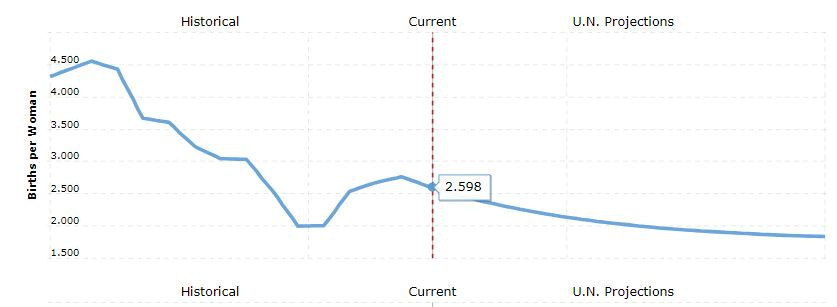The Reasons for Demographic Decline
Every one complains about demographic decline, but what is the root cause?
A recent hour long documentary provided me with an impetus to examine certain trends regarding demography. The real question postulated by the documentary is why aren’t people having children?
There are explanations from various groups… feminism… a lack of childcare… a lack of security… a breakdown of community… Particularly stupid individuals will blame “capitalism” or “patriarchy” as some catch-all boogeyman with no further explanation; Commies tend to not only physically disabled, but mentally as well.
It seemed reasonable to investigate the actual answer to this question. Why aren’t people having children? And what the social drivers are that re-enforce childlessness?
Fertility Rate
Fertility rate is the number of children a that women have on average in a given nation or region. Replacement fertility is considered to be roughly 2.1 children per woman on average (One child to replace each aging parent). When the fertility rate is above 2.1 the population grows (excluding wars and plagues) and when the fertility rate is below 2.1, demographic decline occurs. The United States and nearly the entire planet excluding Sub-Saharan Africa and some parts of the middle east (and Israel) has a fertility rate below replacement levels. In no particular order:
S. Korea-0.71
Japan-1.37
United States-1.8
Russia-1.42
China-1.0
Mexico-1.8
One thing pointed out by the documentary is that demographic decline does not correlate directly to smaller-family-size. A low fertility rate does not mean a large percentage of men and women are electing to have only 1 child (outside of China’s historic 1-child policy repealed in 2016). In most cases, those that want to have children are as likely now as they were 50 years ago to have 2, 3, or more children.
The demographic decline correlates to a sweepingly large number of women (as many as half in Korea or 1 in 3 in the West) electing to have no children at all. Often it’s not a conscious choice, but a choice born of circumstance and short-term hedonistic thinking.
A large number of people point to economic factors: having children is expensive. A large number of people point to Feminism and the education of women directly correlating to reduced fertility. While that is absolutely true, and women being in the work force has been a disaster for human demographics, that does not appear to be the sole contributor. Feminism will eventually come to a harsh decaying end and demographic decline will play a significant role in that.
The long-term problem that causes demographic decline is more complex than a single misled and violently evil ideology.
How Feminism Will Finally End
Between 1950 and 1970 women flooded into the western work force. This occurred for many reasons, but chief among them was corporate propaganda and a general dissatisfaction with life that women were experiencing at the time. To properly understand the flaws of modern feminism and its apocalyptic consequences [not being hyperbolic there], it is necessary…
The Urbanization Correlation
One interesting correlative aspect appeared due to previous research into the Mouse Utopia Experiment. For those who are not already intimately familiar with the Mouse Utopia experiment, the video below provides an excellent explanation of the research and some of the socio-political implications.
The larger structural interest that appears to influence demographic decline is not the number of people, resource allocation, or objectively evil ideologies like Communism or Feminism. It appears as a shadow of other trends we’ve seen in human history. Those who have occupied safe urban centers consistently lose the collective social will to live over several generations.
The real problem, endemic to the industrialized world, seems to be an embedded root cause for self righteous evil sociopaths to promote horrific suicidal ideologies… as well as a social structure that inevitably leads to demographic decline.
I share these ideas and discoveries freely because I think that it’s important. The body politic requires new ideas and individuals able to clarify them… Still, my time isn’t free, and for the less than a large Latte a month you can support my continued efforts to share enlightenment:
Population Density
Utilizing macrotrends as a source, it is possible to come up with a core cause that seems to be roughly consistent across nations and ethnic groups. By looking at rates of urbanization in comparison to fertility one can identify a striking correlation. As nations become more urbanized, fertility rates drop. One could argue that it’s economic (harder to have kids in an apartment) but people have numerous children while living in 1 room shacks all the time. One could argue that the reason is hedonistic (people who live in cities just want to enjoy themselves and be unbounded by the next generation), but that implies an underlying psychological change-of-state that occurs when living in a high-density environment.
The proposition is this: living in high-density environments atomizes the individual to such an extent that producing a family becomes too psychologically taxing. All of the government programs in the world won’t make it possible for people in highly urbanized areas to socio-psychologically bare the burden of the next generation.
From a metaphysical context one could argue that there is too much noise in the collective unconscious for an individual to carve a piece out to form a family. In the context of this type of metaphysics and the noösphere, it makes sense that too many individuals living too tightly produces inherently detrimental psychological states. A discussion that I’ll have in a future publication (the materialists perspective on the collective unconscious, keep a look out for it).
From a statistical standpoint, it appears that when a nation becomes between 72% and 81% urbanized, the fertility rate drops below replacement. It has been theorized that at roughly 70% of carrying capacity human civilizations tend to fall apart. 72% makes sense intuitively due to the special place the number 72 has when it comes to exponentially growing systems.
Thus, somewhere between 71% and 81% urbanization, the national fertility rate is doomed to sink below replacement. On the one hand, this is disastrous looking forward as demographic decline is going to continue until populations are forced to de-urbanize due to resource scarcity. On the other hand, this also indicates that there are simple methods one can use to dramatically increase the likelihood that your own bloodline will live into the future.
Don’t. Live. In. Cities.
Cities have always been a population sink. Historically it was due to war and disease. In the modern era it’s due to mental illness and dropping demographic trends. There appears to be a critical threshold at which societies cease functioning. When exactly that happens depends on the ethnic and cultural makeup of the society. Groups and ethnicities well-suited for high-density lifestyles (India, China) will urbanize past 72% to an urban population approaching 82% before beginning demographic collapse. Those more suited to agrarian lifestyles (Europe, Japan, Persia) will begin a demographic spiral when reaching between 72% and 75% urbanized.
The Statistics
The following are a number of example nations and their urbanization rates in comparison to their fertility rates over time. All the sources are from macrotrends. Feel free to play around with these stats yourself. India is the greatest outlier (India is always an outlier for human civilizations for some reason).
France:
France reached replacement level fertility in 1976 with an average urbanization rate of 73%.
Mexico:
Mexico reached replacement level fertility in 2023 with an average urbanization rate of 81%. One of the highest urbanization levels prior to dropping below replacement level fertility.
Japan:
Japan reached replacement level fertility in 1975 with an average urbanization rate of 76%. Consistently within the trends for most nations.
Russia:
Russia reached replacement level fertility in 1989 with an urbanization rate of 73%
South Korea:
South Korea fell below replacement level fertility in 1984 and an estimated 64% urbanization. The reason why this occurred “early” in South Korea is likely because of how urbanized the nation of S. Korea already was. In comparison to a westerner living “in the country” life in S. Korea was already heavily urbanized even in what would be defined as its rural regions.
The One Industrialized Nation that’s Growing
Hopefully the above data is enough to get the gears turning. What’s interesting is that there do exist a few industrialized nations with growing populations. One of the most interesting is Kazakhstan with a growing ethnic Kazakh population and a shrinking ethnic Russian population.
If we look at the demographic trends and urbanization rates for Kazakhstan, it’s possible to see exactly what’s happening in this nation. A central Asian culture that straddles the line between Europe, Persia and China.
Kazakhstan has effectively stopped urbanizing as of roughly 1989 when the Soviet Union collapsed. In the current year (2023) the fertility rate remains well above replacement at 2.6 children per woman. If a reduced rate of urbanization for the last half-century is indicative of future patterns, Kazakhstan may arise as a great power of Central Asia by virtue of a young vigorous population alone.
This cements the idea that it is urbanization and high-density that may act as a root-cause for demographic decline. Urbanization lends itself toward atomization and the bandying about of horrible ideological rhetoric (like Feminism, and Communism). Urbanization also generates a human environment rather than a natural one… and in a human environment many forms of insanity can be considered ‘acceptable’ if only you change the nature of that environment enough to render them acceptable. There is no “truth” in an atomized urban society, only what people believe to be true.
Economics
As an interesting aside, it seems that dropping below replacement fertility almost always coincides with some type of economic shock. It is proposed that economic shocks occur as a byproduct of hyper-urbanization creating unknown bottlenecks and choke-points in supply chains. A sufficiently urbanized society finds itself weak to severe economic stressors lacking the economic resilience of disconnected rural territories.
Thus, it appears that a major supply shock that occurs between an urbanization level of 71% to 81% nearly always coincides with a drop in national average fertility below replacement level. Many specialists think that it is the supply shock that reduces the fertility rate. While one might agree in the short term, the reason the fertility rate never recovers is the same reason that the supply shock occurred in the first place: over-urbanization and an over-socialized population.
The United States
The United States is following similar trends. The fertility rate dropped below replacement in 1973 at an urbanization level of 73.6% like many European nations. After the oil shock of the 1970s, the population never attained replacement level (2.1) again, but did get close in the late 80s and 90s. The urbanization levels of the United States also never receded, now standing at 83.3% urban population. It was 73.6% in 1973.
That’s not the end of the story. The US (and China and Russia) are so large that there are regions where urbanization levels are still quite low. In those regions one can see replacement level fertility. The side-effect is that the regions of the US that are most rural and disconnected from the rest of the country are the only regions close to maintaining their populations. Those populations in rural regions will have an outsized impact on future demography.
North Dakota, South Dakota, Nebraska and Utah are the regions of the United States with the most stable fertility rate as of 2021. Since then, Utah has further urbanized (mostly people moving in from CA and OR) resulting in a further reduced fertility rate between 2021 and 2024. All regions of the US are below replacement but one can easily see the radically different demographic trends between regions. In all cases, it’s the urbanized 80% of the population that’s dragging down the average.
These trends are the reason I suspect that the next Great Civilizations will emerge in Central Asia (Kazakhstan) in the Missouri River Basin (Central United States) and in South America (Patagonia or Uruguay).
A Future Beyond Materialism: Holistic Civilization
While this is a long article, it contains a lot of background and is well worth the read.
In China, a completely different nation both ethnically and culturally, a similar trend can be observed between provinces.
Just as there are 3 states in the US with a Fertility rate of 2.0 or higher, there are 3 provinces in China with a fertility rate above replacement: Tibet, Guizhou, and GuanXi. The most urbanized provinces along the Pacific Coast from HeiLongJiang to ZheJiang all have populations that are in steep demographic decline.
There isn’t some magic bullet or government mandated program that can unfuck human demographic trends. Over-urbanized over-socialized populations naturally create a state of demographic decay. It’s always been rural populations seed the next generation. If you aren’t already a member of one of those populations, become one.























Well if ever I needed encouragement to move up to the mountains of Hokkaido this essay was it. Time to start packing ;)
Another great essay Copernican.
Good addition to other recent works on this topic, like Johann Kurtz's "It's embarrassing to be a stay at home mom" & "Liberal societies dont have kids", and Joseph Bronski's "Leftism has happened before". Btw what do you think of those articles, if you have read them?